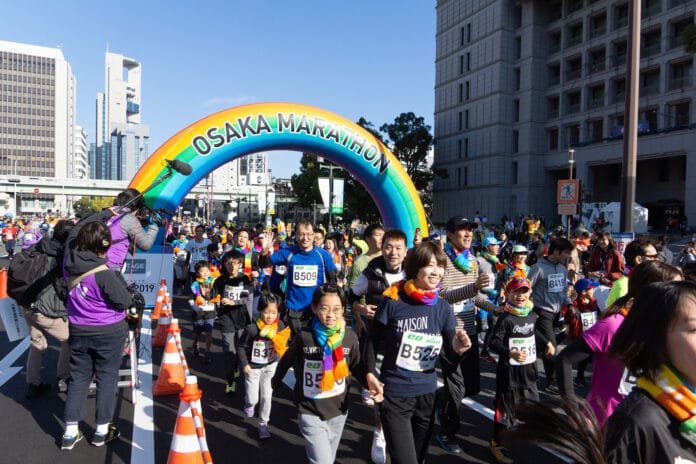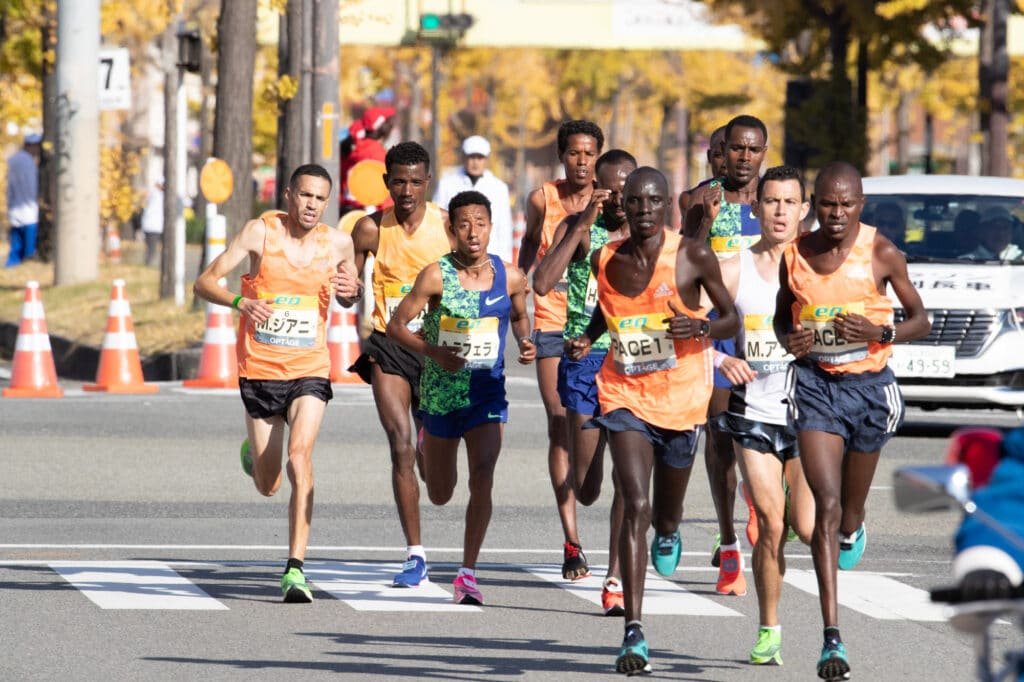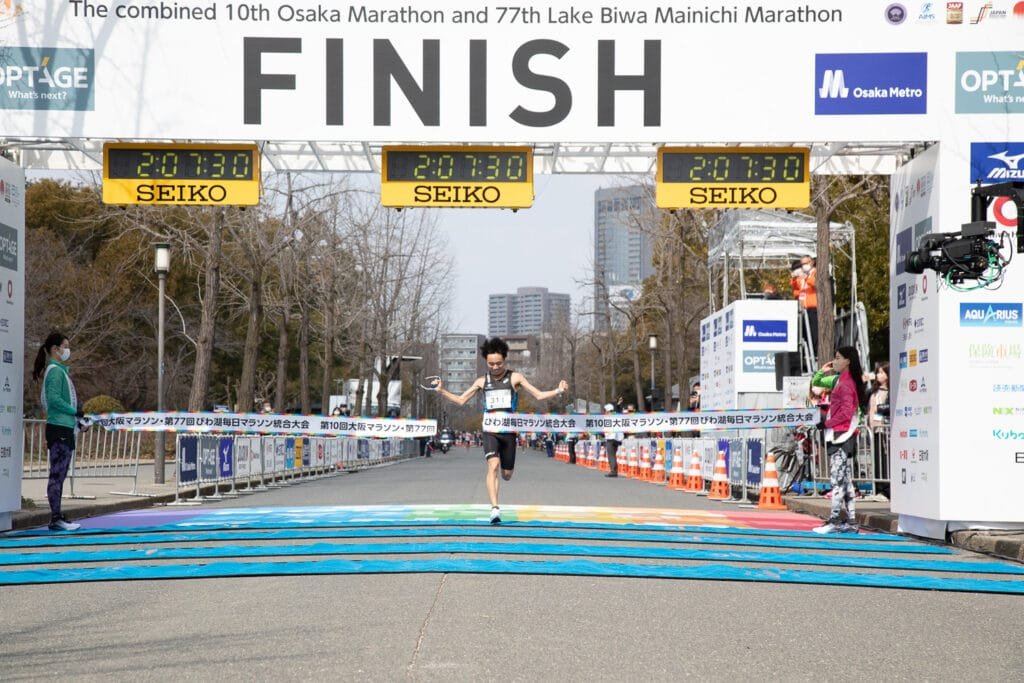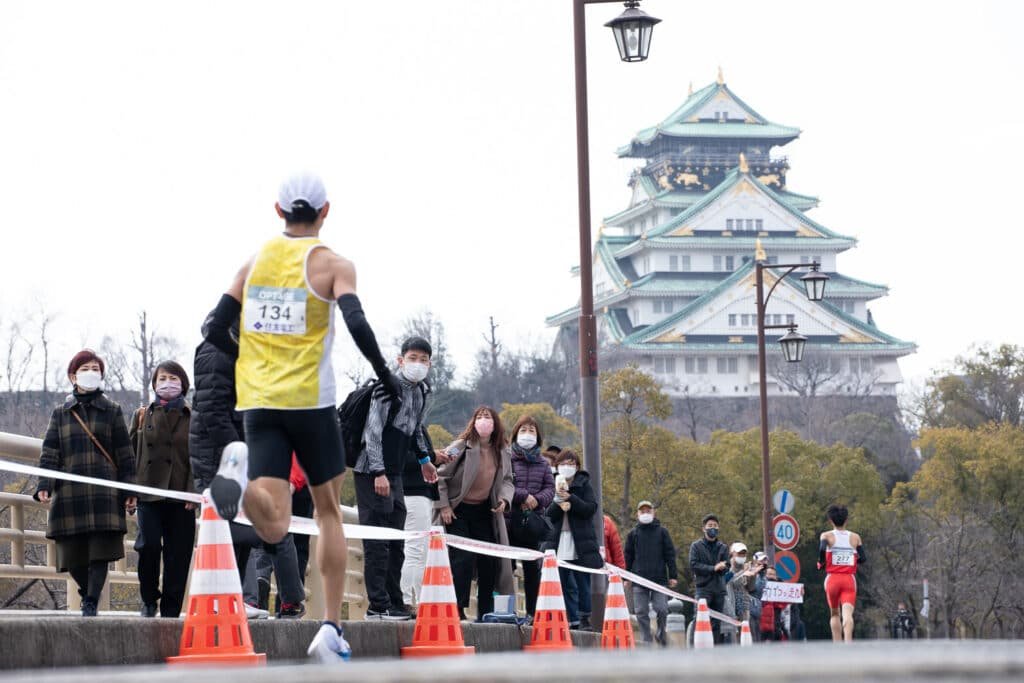
Since 1997, the people of Osaka come together to host this marathon for people of all ages. There is also a separate wheelchair marathon held separately. Over 10,000 people participate, some running full marathons and others half marathons, making it the second largest marathon in Japan.
Table of Contents
What is the Osaka Marathon?
The Osaka Marathon is the largest marathon in Kansai, with a capacity of 35,000 people.
The course starts at the west side of Osaka castle park and finishes at INTEX Osaka, spanning over 40km. Along the route are some of Osaka’s iconic landmarks :
5km – Namba district and Midosuji Blvd
10km – Osaka City Central Public Hall and Osaka City Hall
20km – Kyocera Dome Osaka
25km Tsutenkaku Tower
The event’s slogan is ‘Making a rainbow together,’ and the colors of the rainbow are 7 charity themes such as ‘To support your hopes to live,’ and ‘For the sake of children’s bright future.’ Runners can choose one of these themes to support and funds raised go to that charity. Along the course are ‘Seven colored cheering stations’ that collect charity money and distribute charity merchandise. These stations make it easy for everyone to support the cause.
Due to COVID-19, the 2020 Osaka marathon did not take place. However, in 2022, it returned and the “Lake Biwa Marathon” was also added to the marathon, called “The 10th Osaka Marathon / 77th Lake Biwa Mainichi Marathon Integrated Tournament”. This also serves as the:
・Japan Marathon Championship series
・Japan Qualifying Marathon Trial for the World Athletics World Championships Oregon22
・Japan Qualifying Marathon Trial for the Asian Games Hangzhou 2022
・Marathon Grand Championship Challenge
This took place on Sunday, February 27, 2022, with the following schedule.
- 9:05 a.m. / The wheelchair marathon starts.
- 9:15 a.m. / Marathon Wave 1 starts.
- 9:25 a.m. / Marathon Wave 2 starts.
- 9:40 a.m. / Marathon Wave 3 starts.
- 11:25 a.m. / The wheelchair marathon finishes.
- 4:15 p.m. / The marathon finishes.

History of the Osaka Marathon
Throughout the year, multiple marathons are held throughout Osaka. The two main events are the “Osaka International Ladies Marathon” and the “KIX Quanzhou International Marathon”. However, both events were difficult for people to participate in. In comparison, the “Tokyo Marathon” started in 2007 and has since become the largest citizen marathon event in Japan. This led to the Osaka governor, Toru Hashimoto, questioning why they could not make a similar event. The result was the creation of a large-scale marathon event, known as “The Osaka Marathon”. In 2009, The Osaka Marathon Preparatory Committee formed and aimed to hold the first event from October to December 2011. A co-sponsored newspaper known as the Yomiuri Shimbun helped to publicise the event, calling for participants of all ages and announcing that the first event would take place on October 30, 2011.
The first marathon had a theme around “charity”, with a course condensed around many of Osaka’s famous landmarks, such as Osaka Castle, Namba, Midosuji, Nakanoshima and Tsutenkaku. Following the success of the marathon, the Organising Committee partnered with the Chicago Marathon, one of the major marathons in the world. Chicago is a sister city of Osaka and there was the aim to bring people overseas to join the Osaka marathon. In 2015, the two cities formed an alliance and various exchanges have taken place, such as Chicago Marathon officials visiting the chairman of the Organizing Committee in Osaka.

Osaka Marathon Course
Start ~ 5km (Osaka Prefectural Office ~ Osaka City Hall)
The start is inevitably the most crowded part of the marathon. The narrow curves and roads made it difficult for runners to move freely and without getting injured. Therefore, from the 9th tournament in 2019, the marathon split into different groups, for safety. Even though there are different groups, if you are at the far back, it takes a couple of minutes just to get past the starting point. After the start, it is downhill until approximately 2km, so it is important for runners to control their pace without injuring others. From 2km, the course is flat with lots of people cheering from all sides.
5km – 15km (Osaka City Hall – Namba – Kyocera Dome)
This section of the race passes through many monuments such as the Central Public Hall, Osaka City Hall, and the Glico sign near Namba. Here, the roadside supporters are in full force, chanting and supporting all the runners. The first water stop is around the 5km mark at Osaka City Hall. The 5km is typically crowded as most people stop for water. From the 5km point, the straight line of Midosuji Boulevard continues for about 3km to Namba, and the course circles Kyocera Dome at around 10km to 15km.
15km – 25km (Kyocera Dome – Kishizato – National Theater of Literature)
This section will take runners from Kyocera Dome to the National Theater of Literature via a turnaround in Kishizato. This section of the marathon is flat but from 25km, there are many slopes. Therefore, runners tend to conserve energy for the next section.
25km – 35km (National Literature Theatre – Tsutenkaku Tower – Shitennoji Temple – Oike Bridge)
This section is the most difficult in the entire course, with ups and downs of up to 20m in height difference. However, the scenery of Osaka is beautiful with various landmarks such as Tsutenkaku Tower near Tennoji Temple, Shitennoji Temple, and Abeno Harukas. From the 29km mark, there is a food service zone, known as “Maido Aid”. At around the 18km and 22km mark, there are small stands offering small confectioneries such as energy bars. However, at 29km, the largest stand offers a variety of goods to help replenish your energy such as, cucumber ice cream, cream puffs, dried fruit, warabimochi and even karaage (fried chicken)!
After passing the food service zone, the course heads north for approximately 5km on the flat road of Imazato-suji. This is the easiest part of the course due to its flat and wide roads. Just at the 40km point, there is an underpass that passes under the JR Loop Line, and after passing through the underpass, you will reach the last 2km of the race. This is maybe one of the most excruciating parts, as the incline up to Osaka Castle is the final climb. In addition, a host of supporters as well as a media crew and, of course, the finish line, end the marathon.
35km – Goal (Oike Bridge – Osaka Castle Park)
After passing the food service zone, the course heads north for approximately 5km on the flat road of Imazato-suji. This is the easiest part of the course due to its flat and wide roads. Just at the 40km point, there is an underpass that passes under the JR Loop Line, and after passing through the underpass, you will reach the last 2km of the race. This is maybe one of the most excruciating parts, as the incline up to Osaka Castle is the final climb. A host of supporters as well as a media crew and, of course, the finish line, end the marathon.

Past Winners of Osaka Marathon
Below is a list of the past winners of the Osaka Marathon. In the most recent marathon, Gaku Hoshi was the first Japanese national to win the event, also breaking the record at 2hours 7 minutes and 31 seconds.
The 2020 and 2021 marathons were canceled due to COVID-19 therefore no records are available.
2011 – Elijah Sang (Kenya) – 2:12:43
2012 – Ser-Od Bat-Ochir (Mongolia) – 2:11:54
2013 – Jackson Limo (Kenya) – 2:12:06
2014 – Jackson Limo (Kenya) – 2:11:43
2015 – Daniel Kosgei (Kenya) – 2:13:46
2016 – Benjamin Ngandu (Kenya) – 2:12:47
2017 – Kalaeb Selomon (Eritrea) – 2:12:03
2018 – Charles Munyeki (Kenya) – 2:14:11
2019 – Asefa Tefera (Ethiopia) – 2:07:47
2022 – Gaku Hoshi (Japan) – 2:07:31 Record
Osaka Marathon’s Special Song
Leading up to the 4th marathon in 2014, the popular Japanese duo, “Kobukuro”, announced their theme song “42.195km”. During the 10 days from October the 1st to the 10th, the song was free to download with the artists saying: “I want the participating runners to feel free to listen to it during the practice period”. The song was also played along with all stations of the Osaka Municipal Subway stations where the marathon would take place.
In 2019, a new song was released by Kobukuro, called “Osaka Soul” and is now the current theme song of the marathon.
Marathon Application
Applications can be sent online with a participation fee of 23,000 yen. If the number of applicants exceeds 30,000, a lottery will determine who can participate. The selected applicants will then pay the entrance fee.
The marathon runners have various categories (with the approximate number of participants listed below):
General runners (individual): 16,320 participants
Runners in a racing wheelchair: 30 participants
Civic athletes (1,500 participants / on a first-come, first-served basis)
Osaka Sports Supporting Runners (400 participants each from Osaka Prefecture and Osaka City; 800in total / on a first-come, first-served basis)
Participants who have donated at least 100,000 yen to the Namihaya Sports Promotion Fund (Osaka Prefecture) or the Osaka City Sports Promotion Fund (Osaka City) through the Furusato Nozei Program.
Charity runners (1,000 participants / on a first-come, first-served basis)
Participants who have collected at least 70,000 yen in donations for a charity organization designated by the Osaka Marathon.
Runners with disabilities (50 participants)
Those with disabilities who have either of the following certificates: shintai shogaisha techo (physically disabled person’s certificate), seishinshogaisha hoken fukushi techo (mentally disabled person’s certificate) or ryoiku techo (certificate of medical treatment and education for the intellectually disabled) (except runners in a racing wheelchair).
Elite runners (planned to include 250 men and 50 women)
Japan Association of Athletics Federations (JAAF) registered members.
Note
Unfortunately, applications from overseas are not accepted.

How to Enjoy the Osaka Marathon
Watch Roadside
Anyone is free to watch roadside, with different sections offering different spectacles. The initial rush of the start is exciting and thrilling as you can watch thousands of runners all race at once. During the middle of the marathon, the runners become more separated, so it is a good chance to see your favourite runners or the speed of the competitors at the front. In the end, it is the most thrilling part of the race as it comes to a close. Seeing who comes out on top and how quickly they will finish makes for an exciting climax. You can also enjoy many of Osaka’s famous landmarks along the way, making for an exciting day out in the city!
Watch on Television
For those that want to keep up with the marathon standings and events, it is broadcast from the very start at 8:40AM, all the way to the end at 16:20. The main broadcasting channels are NHK (Japan Broadcasting Corporation), YTV (Yomiuri Telecasting Corporation), MBS (Mainichi Broadcasting System, Inc.) with live commentary.

Final
The Osaka Marathon is one of the largest events in the calendar year. Seeing world class level running from professional athletes is a must for any running enthusiast. However, for more casual viewing, watching the spirit and pride of the people of Osaka come together in the event is exciting, joyous and eventful.





















Event date is: Sunday, February 26, 2023
Thank you!
Thank you for sharing this wonderful article on osakas marathon.